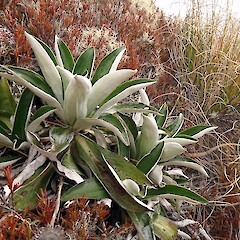Celmisia holosericea
Common name
mountain daisy
Synonyms
None
Family
Asteraceae
Flora category
Vascular – Native
Endemic taxon
Yes
Endemic genus
No
Endemic family
No
Structural class
Herbs - Dicotyledonous composites
NVS code
The National Vegetation Survey (NVS) Databank is a physical archive and electronic databank containing records of over 94,000 vegetation survey plots - including data from over 19,000 permanent plots. NVS maintains a standard set of species code abbreviations that correspond to standard scientific plant names from the Ngä Tipu o Aotearoa - New Zealand Plants database.
CELHOL
Chromosome number
2n = 108
Current conservation status
The conservation status of all known New Zealand vascular plant taxa at the rank of species and below were reassessed in 2017 using the New Zealand Threat Classification System (NZTCS) – more information about this can be found on the NZTCS website. This report includes a statistical summary and brief notes on changes since 2012 and replaces all previous NZTCS lists for vascular plants.
Please note, threat classifications are often suggested by authors when publications fall between NZTCS assessment periods – an interim threat classification status has not been assessed by the NZTCS panel.
- Conservation status of New Zealand indigenous vascular plants, 2017 . 2018. Peter J. de Lange, Jeremy R. Rolfe, John W. Barkla, Shannel P. Courtney, Paul D. Champion, Leon R. Perrie, Sarah M. Beadel, Kerry A. Ford, Ilse Breitwieser, Ines Schönberger, Rowan Hindmarsh-Walls, Peter B. Heenan and Kate Ladley. Department of Conservation. Source: NZTCS and licensed by DOC for reuse under the Creative Commons Attribution 4.0 International licence.
2017 | At Risk – Declining | Qualifiers: DP
Previous conservation statuses
2012 | Not Threatened
2009 | Not Threatened
2004 | Not Threatened
Distribution
Endemic. New Zealanbd: South Island (Fiordland).
Habitat
Coastal to lowland to lower subalpine rocky places, grassland, herb-field.
Detailed description
Large tufted herb with leaves all radical, sheaths imbricate around stout stem. Lamina 120–300 × 25–65 mm, coriaceous, oblong-to elliptic-lanceolate; upper surface glabrous; lower surface densely clad in closely appressed white satiny tomentum, midrib prominent, dark; apex acute to subacuminate, usually distinctly apiculate; margins flat, rather distantly denticulate, narrowed to base or very short broad petiole. Sheath ± 40 × 15 mm, coriaceous, glabrous, ribbed. Scape stout to rather slender, angled or flattened, ± 180–600 mm long. Bracts linear-subulate, c. 25–35 mm long (outer up to 50 mm). Capitula 50–70 mm diameter, subtending bracts similar to upper scape-bracts. Involucral bracts 10–25 mm long; inner narrow, glabrous, glandular-pubescent; outer broader, lanceolate, tomentose without. Ray florets numerous, c. 25 mm long, narrow; limb gradually widening to obtuse 3-toothed apex. Disk florets tubular to funnelform, c. 7–8 mm long. Achenes 5–6 mm long, obovoid-compressed to subfusiform, densely clad in short ascending hairs. Pappus hairs c. 5–7 mm long, white to sordid-white, becoming rufous.
Flowering
November–January
Flower colours
White, Yellow
Fruiting
December–March
Life cycle
Pappate cypselae are dispersed by wind (Thorsen et al., 2009).
Propagation technique
Difficult. Can be grown from fresh seed but requires a shaded, permanently moist situation.
Etymology
celmisia: Apparently named after Kelmis, one of Idaean Dactyls, a group of skilled mythical beings associated with the Mother Goddess Rhea in Greek mythology. Kelmis, whose name means ‘casting’, was a blacksmith and childhood friend of Zeus, son of Rhea and later king of the gods. In Ovid’s ‘Metamorphoses’, Kelmis is described as offending Zeus who turned him into adamant so he was as hard as a tempered blade
Where To Buy
Occasionally available from specialist native plant nurseries.
Attribution
Description adapted from Allan (1961).
References and further reading
Allan HH. 1961. Flora of New Zealand, Volume I. Indigenous Tracheophyta: Psilopsida, Lycopsida, Filicopsida, Gymnospermae, Dicotyledones. Government Printer, Wellington, NZ. 1085 p.
Thorsen MJ, Dickinson KJM, Seddon PJ. 2009. Seed dispersal systems in the New Zealand flora. Perspectives in Plant Ecology, Evolution and Systematics 11: 285–309. https://doi.org/10.1016/j.ppees.2009.06.001.













